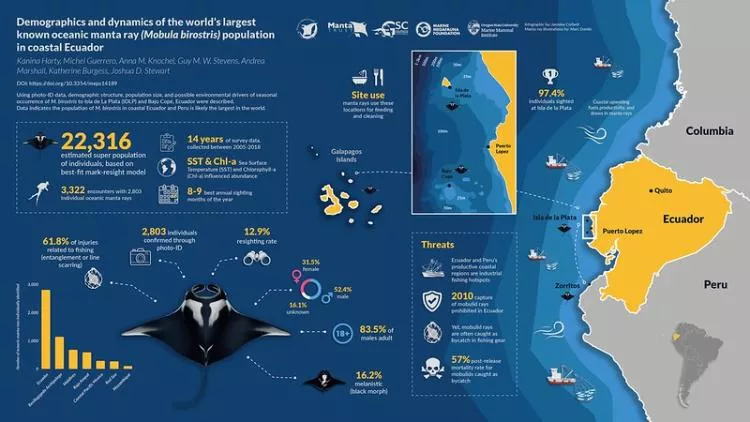Largest known manta ray population is thriving off the coast of Ecuador
Scientists have identified off the coast of Ecuador a distinct population of oceanic manta rays that is more than 10 times larger than any other known subpopulation of the species, Oregon State University reports.
Although manta rays are readily capable of long-distance movements of hundreds if not thousands of kilometres, most populations appear to be philopatric (tending to return to or remain near a particular site or area—ed.) with few examples of long-distance dispersal.
Oceanic manta rays, the largest ray species, were listed as threatened under the U.S. Endangered Species Act in 2018. In 2019, their threat category increased from vulnerable to endangered on the International Union for the Conservation of Nature’s Red List.
Population dynamics are, however, notoriously difficult to study because the rays tend to spend their time in offshore locations that are hard for researchers to access, and their visitation patterns can be unpredictable.
But in the late 1990s, it was discovered that a population of oceanic manta rays aggregate in August and September each year around Isla de la Plata off the coast of Ecuador, where they are relatively easy to locate and study. It is also a popular diving area, and visitors take numerous photographs of the animals, providing researchers with a trove of data.
Unique pattern
As each manta ray has a unique spot pattern on its belly, photos of individual rays taken by researchers and scuba divers made it possible for scientists to identify individual animals and track their movements and locations over time.
Data collected between 2005 and 2018 enabled the researchers to identify more than 2,800 individual rays and estimate a total population of more than 22,000. The researchers’ findings suggest that conditions in the region are particularly favourable for a large, healthy manta ray population.
That is significantly larger than what we’ve seen in oceanic manta ray populations elsewhere. This is by far the largest population that we know of.
Guy Stevens, chief executive and founder of The Manta Trust.
Fact file
The best-fit mark−resight model estimated a super-population size of 22,316 individuals, with annual estimated abundances of 949−7,650 females and 5,226−9,340 males. A localised sampling of this highly mobile species limits the interpretations of mark-resight analyses, but provides lower bounds for total abundance that indicate the population of M. birostris in coastal Ecuador and Peru is likely the largest in the world.












































